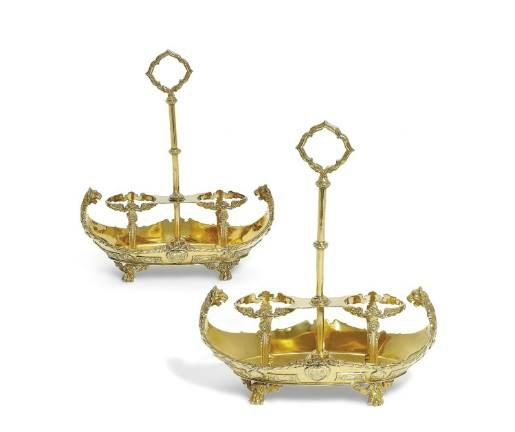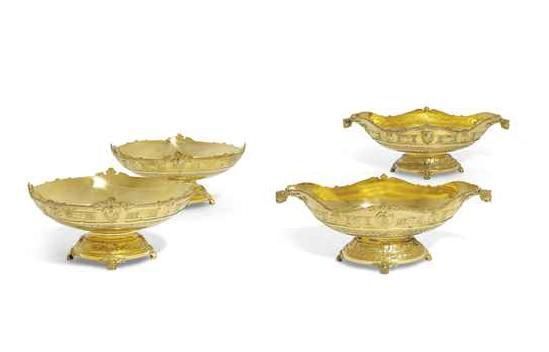Christie's Exceptional Sale 2013 evening auction realises $22.9 million
The Maharaja of Patiala’s banqueting service sets a record price for an English dinner service sold at auction realising £1.9 million / $2.9 million / €2.3 million. Photo: Christie's Images Ltd 2013.
LONDON.- The Exceptional Sale evening auction realised £14,990,450/$22,845,446/€17,553,817 selling 69% by lot and 79% by value. The top price was paid for the Maharaja of Patiala’s banqueting service which realised £1,965,875/$2,995,994/€2,302,040 (estimate: £1 million – 1.5 million), setting a world record price for an English dinner service sold at auction.
Robert Copley, Deputy Chairman Christie’s UK, International Head of Furniture and Decorative Arts, Christie’s London: “The very strong results witnessed in this evening’s sale build on the success of this pioneering sales platform, first established at Christie’s in 2008, and demonstrate the enduring appeal of masterpieces of European furniture and decorative arts. These works were highly admired over the past few weeks while they have been exhibited alongside highlights of the Old Master, Impressionist, Modern and Contemporary art in London and when they toured to Moscow, Hong Kong and Monaco. The collectors engaging in this market continue to be increasingly international. This evening we saw competitive bidding across all categories, from clocks to furniture with royal provenance in the room, on the telephones and via Christie’s LIVE. Several records were set including a world record auction price for the enamel plaque by Henry Bone which was purchased by the Cleveland Museum of Art. We are delighted that the Sèvres porcelain ormolu-mounted blue-ground vase-clock was purchased by Chateau de Versailles and will be returning to its original home.”
Top Lot
- The top price was paid for the Maharaja of Patiala’s banqueting service which realised £1,965,875/$2,995,994/€2,302,040 (estimate: £1 million – 1.5 million), setting a world record price for an English dinner service sold at auction. Commissioned by the Maharaja in honour of a tour of India in 1922 by Prince Edward, Prince of Wales, later King Edward VIII and Duke of Windsor, this extensive George V silver-gilt dinner-service comprises over 1,400 pieces. The Maharaja’s wealth and status was such that he was the first man in India to own an aircraft, for which the Patiala Aviation Club was founded. The Maharaja was also an avid and early motorcar enthusiast; indeed legend has it that he would travel in a motorcade of 20 Rolls Royces.
The Maharaja of Patiala will be auctioning his 1,400-piece dinner set this Thursday. Weighing nearly 500 kg, this silver-gilt dinner set was especially commissioned for a visit to Patiala by the Prince of Wales, who later became King Edward VIII in 1922. It weighs about 500 kgs. Photo: Christie's Images Ltd 2013.
Highlights of the Auction:
 - A magnificent bronze model of an écorché horse relating to ‘The anatomy of a horse in patinated metal above a carved marble quadrilateral plinth’ that was documented in an inventory of 1810 of the workshop of Giuseppe Valadier, the celebrated Roman bronze founder, architect and designer fetched £1,405,875/$2,142,554/€1,646,280 (estimate: £500,000 – 800,000). It is one of four casts known to exist on this scale and is the only one in private hands.
- A magnificent bronze model of an écorché horse relating to ‘The anatomy of a horse in patinated metal above a carved marble quadrilateral plinth’ that was documented in an inventory of 1810 of the workshop of Giuseppe Valadier, the celebrated Roman bronze founder, architect and designer fetched £1,405,875/$2,142,554/€1,646,280 (estimate: £500,000 – 800,000). It is one of four casts known to exist on this scale and is the only one in private hands.
 - A Sèvres porcelain ormolu-mounted blue-ground vase-clock and cover recorded to have been in the Cabinet des bains in Louis XVI's apartments at Versailles was purchased by Chateau de Versailles for £433,875/$661,226/€508,068 (estimate: £120,000 - 180,000).
- A Sèvres porcelain ormolu-mounted blue-ground vase-clock and cover recorded to have been in the Cabinet des bains in Louis XVI's apartments at Versailles was purchased by Chateau de Versailles for £433,875/$661,226/€508,068 (estimate: £120,000 - 180,000).
 - An enamel plaque by Henry Bone, R.A. (1755 – 1834) depicting Bacchus and Ariadne, the artist’s largest and greatest work, realised £313,875/$478,346/€367,548 (estimate: £80,000 – 120,000) setting a world auction record price for a work by the artist at auction. Henry Bone’s success as an enamellist was cemented when he was officially appointed Enamel Painter to the Prince of Wales, later Prince Regent, and to George III. Bacchus and Ariadne was purchased by George Bowles, an enthusiastic collector of Bone’s work, from the artist for 2,200 guineas in 1811.
- An enamel plaque by Henry Bone, R.A. (1755 – 1834) depicting Bacchus and Ariadne, the artist’s largest and greatest work, realised £313,875/$478,346/€367,548 (estimate: £80,000 – 120,000) setting a world auction record price for a work by the artist at auction. Henry Bone’s success as an enamellist was cemented when he was officially appointed Enamel Painter to the Prince of Wales, later Prince Regent, and to George III. Bacchus and Ariadne was purchased by George Bowles, an enthusiastic collector of Bone’s work, from the artist for 2,200 guineas in 1811.
 - An exceptional piece by David Roentgen, the most celebrated German cabinet-maker of the late 18th century realised £625,875/$953,834/€732,900 setting a world record price for the maker at auction (estimate: £400,000 – 600,000). Decorated with enchanting chinoiserie scenes in Roentgen’s trademark marquetry à la mosaique and mounted with jewel-like ormolu mounts, this splendid roll-top desk is a superb example of Roentgen’s work at the height of his career.
- An exceptional piece by David Roentgen, the most celebrated German cabinet-maker of the late 18th century realised £625,875/$953,834/€732,900 setting a world record price for the maker at auction (estimate: £400,000 – 600,000). Decorated with enchanting chinoiserie scenes in Roentgen’s trademark marquetry à la mosaique and mounted with jewel-like ormolu mounts, this splendid roll-top desk is a superb example of Roentgen’s work at the height of his career.
 - The Ogden Mills ‘Armoires à Sept Medailles’ fetched £935,475/$1,425,664/€1,095,441 (estimate: £1 million – 1.5 million). These extraordinary armoires were acquired circa 1910 by the philanthropist and collector Ogden Mills (1857-1929) for his Parisian residence. They are lavishly decorated with spectacular gilt-bronze mounts that fuse seamlessly with the scrolling foliate pattern of the sumptuous ground of brass and tortoiseshell première and contre-partie marquetry. The Louis XIV armoire in contre partie is attributed to André-Charles Boulle, while the late Louis XV is by Delorme.
- The Ogden Mills ‘Armoires à Sept Medailles’ fetched £935,475/$1,425,664/€1,095,441 (estimate: £1 million – 1.5 million). These extraordinary armoires were acquired circa 1910 by the philanthropist and collector Ogden Mills (1857-1929) for his Parisian residence. They are lavishly decorated with spectacular gilt-bronze mounts that fuse seamlessly with the scrolling foliate pattern of the sumptuous ground of brass and tortoiseshell première and contre-partie marquetry. The Louis XIV armoire in contre partie is attributed to André-Charles Boulle, while the late Louis XV is by Delorme.
 - A Saxon enamelled gold and hardstone snuff-box by Johann-Christian Neuber (1736-1808) was sold for £625,875/$953,834/€732,900. It is one of a small group of Neuber’s snuff-boxes in which the beauty and rarity of the stone is given greater emphasis than the gold-work (estimate: £250,000 – 350,000). Lapis-lazuli, which had to be imported from Afghanistan, was one of the only hardstones Neuber used that was not found in Saxony. Its unique, intense colour and composition could not be reproduced by any other stone.
- A Saxon enamelled gold and hardstone snuff-box by Johann-Christian Neuber (1736-1808) was sold for £625,875/$953,834/€732,900. It is one of a small group of Neuber’s snuff-boxes in which the beauty and rarity of the stone is given greater emphasis than the gold-work (estimate: £250,000 – 350,000). Lapis-lazuli, which had to be imported from Afghanistan, was one of the only hardstones Neuber used that was not found in Saxony. Its unique, intense colour and composition could not be reproduced by any other stone.

/https%3A%2F%2Fprofilepics.canalblog.com%2Fprofilepics%2F1%2F0%2F100183.jpg)
/https%3A%2F%2Fstorage.canalblog.com%2F03%2F02%2F119589%2F96711876_o.jpg)
/https%3A%2F%2Fstorage.canalblog.com%2F11%2F31%2F119589%2F94773502_o.jpg)
/https%3A%2F%2Fstorage.canalblog.com%2F20%2F83%2F119589%2F94772815_o.jpg)
/https%3A%2F%2Fstorage.canalblog.com%2F26%2F72%2F119589%2F75604929_o.jpg)
/https%3A%2F%2Fstorage.canalblog.com%2F59%2F60%2F119589%2F26458628_o.jpg)











/http%3A%2F%2Fstorage.canalblog.com%2F84%2F65%2F119589%2F94725174_o.jpg)
/http%3A%2F%2Fstorage.canalblog.com%2F39%2F03%2F119589%2F93530904_o.jpg)
/image%2F1371349%2F20240418%2Fob_ac5c4c_telechargement.jpg)
/image%2F1371349%2F20240418%2Fob_709b64_304-1.jpg)